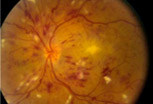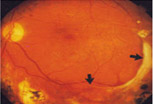| |
 |
|
 |
| Diabetic Retinopathy |
 |
| Incidence of Diabetic Retinopathy: |
 |
 |
 |
14 million diabetics risk loss of sight without early treatment. It is amongst the 2nd most common cause of preventable blindness in India after Cataract. Diabetes affects the Retina which is an important structure in the eye containing the Nerve of the eye (Optic Nerve), Blood vessels and the structures which make us SEE. Diabetes causes the blood vessels to become weak and over a period of time these weak vessels start bleeding ,resulting in gradual VISION LOSS.
|
|
 |
| Definition of Diabetic Retinopathy: |
 |
If you have diabetes mellitus, your body does not use and store sugar properly. High blood-sugar levels can damage blood vessels in the retina, the nerve layer at the back of the eye that senses light and helps to send images to the brain. The damage to retinal blood vessels is referred to as diabetic retinopathy. The disorder usually occurs in both eyes. These changes may include microaneurysms, retinal hemorrhage, macular edema, development of new and leaky blood vessels, and vitreous hemorrhages etc. Diabetic retinopathy can seriously affect vision and, if left untreated, cause blindness. |
 |
| Types of Diabetic Retinopathy |
 |
| In a very broad sense, there are two types of diabetic retinopathy : |
 |
 |
Non-proliferative diabetic retinopathy (NPDR) |
 |
Proliferative diabetic retinopathy (PDR) |
|
 |
 |
| Early Diabetic Retinopathy with Microhemorrhages |
|
 |
NPDR, commonly known as background retinopathy, is an early stage of diabetic retinopathy. In this stage, tiny blood vessels within the retina leak blood or fluid. The leaking fluid causes the retina to swell or to form deposits called exudates. The beginning stages of diabetic retinopathy may cause blurriness in your central or peripheral (side) vision, or it may produce no visual symptoms at all. It mainly depends on where the blood vessel changes are taking place in your retina. Many people with diabetes have mild NPDR, which usually does not affect their vision.
|
|
 |
When vision is affected it is the result of macular edema and / or macular ischemia. Macular edemais swelling, or thickening, of the macula, a small area in the center of the retina that allows you to see fine details clearly. The swelling is caused by fluid leaking from retinal blood vessels. It is the most common cause of visual loss in diabetes. Vision loss may be mild to severe, but even in the worst cases, peripheral vision continues to function. Macular ischemia occurs when small blood vessels (capillaries) close. Vision blurs because the macula no longer receives sufficient blood supply to work properly.
PDR is present when abnormal new vessels (neovascularization) begin growing on the surface of the retina or optic nerve. The main cause of PDR is widespread closure of retinal blood vessels, preventing adequate blood flow. The retina responds by growing new blood vessels in an attempt to supply blood to the area where the original vessels closed. Unfortunately, the new, abnormal blood vessels do not re-supply the retina with normal blood flow. The new vessels are often accompanied by hemorrhage, scar tissue that may cause wrinkling or detachment of the retina. PDR may cause more severe vision loss than NDPR because it can affect both central and peripheral vision. |
 |

|

|
| Moderate |
Advanced |
| PDR-Proliferative Diabetic Retinopathy |
|
 |
If you have diabetes this does not necessarily mean that your sight will be affected, but there is a higher risk. |
 |
| Detection of Diabetic Retinopathy-what a diabetic patient should know and do |
 |
Since this disease can cause blindness, early diagnosis and treatment is essential. If you have diabetes or you have a family history of diabetes, you should have your eyes examined at least once a year by an ophthalmologist.
During a thorough, comprehensive eye examination, your doctor gets to know you, your family history, your lifestyle and your vision needs. Your eyes will be dilated with eyedrops to help the eye surgeon see the retina in greater detail The interior of your eyes may also be photographed to monitor the progression of disease. The tests done to monitor Diabetic Retinopathy are:
Digital Retinal Angiography:
Serial photographs of the eye are taken,to identify leaking blood vessels and the extent of damage in the retina.This is a OPD procedure.
Optical Coherence Tomography: OCT- Optical coherence tomography is a new, noninvasive, noncontact, imaging technology capable of producing cross-sectional images of the living human retina with extremely high resolution.Very accurate in giving details of fluid in the retina caused by diabetes. |
 |
| Treatment of Diabetic Retinopathy |
 |
|
 |
The best treatment is to prevent the development of retinopathy as much as possible. Strict control of your blood sugar will significantly reduce the long-term risk of vision loss from diabetic retinopathy. If high blood pressure and kidney problems are present, they need to be treated as well.
Your ophthalmologist may suggest green laser in which a strong light beam is aimed onto the retina to shrink the abnormal vessels. Lasers have been proved to reduce the risk of severe vision loss from this type of diabetic retinopathy by 75 percent.
|
|
Intravitreal Injections like Avastin & Lucentis reduce the chances of Vision loss secondary to diabetes. These may be prescribed by your Surgeon along with the Laser treatment. |
|
 |
|
 |
Diagnosing diabetic retinopathy early is the best way to prevent vision loss. |
 |
You may call or take an appointment for Diabetic Eye Check up by e-mail.
Contact Us for an appointment |
| |
| |